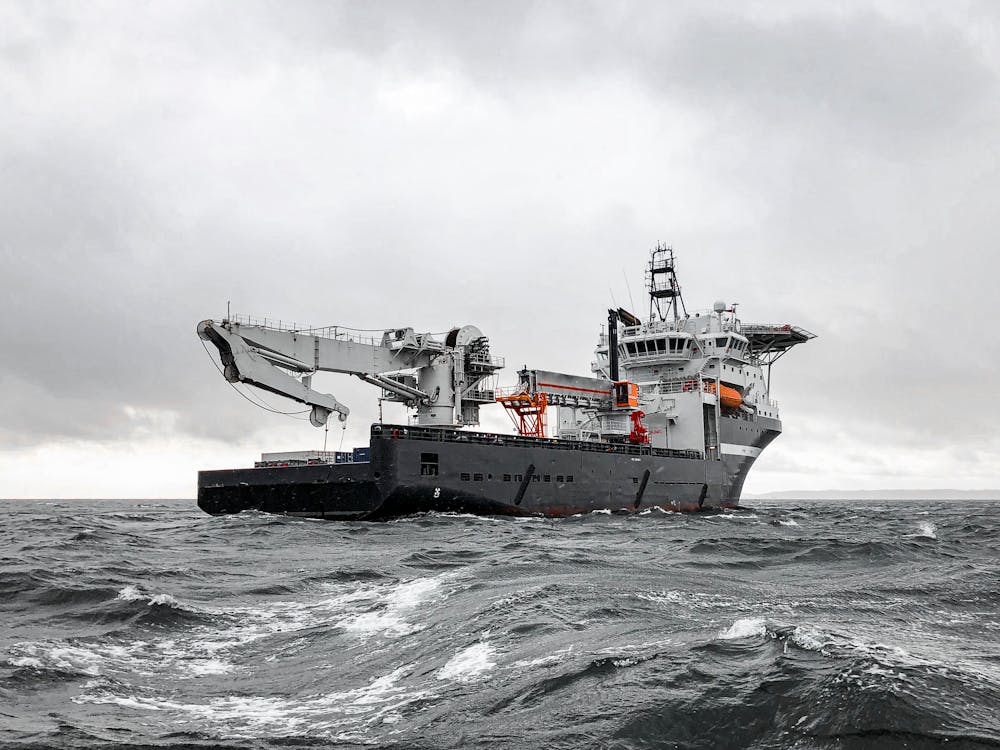Discover how to verify the structural integrity of these structures using environmental loads using Ansys Aqwa.
Understanding Fluid Structure Interaction
Fluid-Structure Interaction (FSI) is a phenomenon that occurs when a fluid and a structure interact with each other. In the context of offshore and marine structures, FSI refers to the interaction between the structural elements and environmental loading, primarily wind, waves, and currents. Understanding FSI is crucial for the design and analysis of offshore structures, particularly for floating structures, where hydrodynamic behavior in open seas is more complex than for fixed structures. By considering the dynamic behavior of the fluid and its interaction with the structure, engineers can ensure the safe operation of structures and moorings of,
- Floating production, storage, and offloading (FPSO) systems
- SPARs, and Semi-submersibles
- Tension leg platforms (TLPs)
- Renewable energy systems
- Ships and breakwaters



Challenges faced in Offshore and Marine Structures
- We must consider the motion of the water, the motion of the structure, and the interactions between the waves and the structure ('Seakeeping', motions due to the environment, and 'Maneuvering', motions due to the ship’s propulsion).
- Ocean waves consist of waves varying in frequencies and directions, leading to complex mathematical modeling due to interactions between waves from different directions. Literature offers various simplified theories including: 1) the linear wave model (Airy waves), 2) Stokes waves, and 3) Irregular waves.
- Winds not only generate wind-induced waves but also directly exert loads on marine structures, especially when the portion above the mean water surface is substantial. Winds are associated with three primary aspects: a mean velocity, a mean speed profile, and turbulence.
- Currents may impose significant loads, particularly on moored vessels and offshore structures. Finally, fixed tensions or forces (Winch Line and Force Line) or thruster forces (External Static Forces) exerted at designated points on a structure can impact its stability.
Methods and Techniques for Analyzing Fluid Structure Interaction
Ansys provides solutions for floating and fixed offshore and marine structures subjected to wave loading. The complexity of modeling depends on the particular application. The Ansys toolset provides solutions across the following options,
- Slender Bodies: Ansys Aqwa / Ansys Mechanical Offshore
- Global Assessment of Large Bodies: Ansys Aqwa
- Detailed Assessment of Response to Complex Wave Loading: Ansys Fluent / CFX
Ansys Aqwa is a modularized, fully integrated hydrodynamic analysis suite based around three-dimensional diffraction/radiation methods: Diffraction, when a large body interferes with an approaching incident wave, and Radiation, when the body is free to move and generates additional waves. Ansys Workbench implementation provides a modern interface to develop and solve Aqwa models. This approach applies to the fixed structure on the video shown below. However, for viscous-dominated problems (such as breaking waves and turbulence), it is recommended to use CFD, as in the case of the platform on the next video.
Ansys Aqwa can simulate linearized hydrodynamic fluid wave loading on floating or fixed rigid bodies. This is accomplished by employing three-dimensional radiation/diffraction theory and/or Morison’s equation in regular waves in the frequency domain. Unidirectional or multiple directional second order drift forces are evaluated by the far-field, or near field solution, or full quadratic transfer function (QTF) matrix. Free-floating hydrostatic and hydrodynamic analyses in the frequency domain can also be performed. Here some capabilities,
- Diffraction/Radiation calculations including Morison elements (Slender bodies)
- Multiple body hydrodynamic interaction (up to 50 structures, up to 20 interacting groups)
- Modelling of moorings, fenders and articulations (connectors)
- Regular Waves, multi-directional wave spectra (long- and short-crested), currents, wind, and additional structure forces
- Static and dynamic stability
- Estimation of equilibrium position
- Frequency domain dynamic analyses
- Time domain with irregular waves, including slow drift effects
- Time domain with non-linear survival waves
- Coupled cable dynamics
- Transfer of motions and pressures to Ansys Mechanical models
Common outputs
- Hydrostatic properties (does it float?)
- Wave force/moment coefficients
- Frequency-dependent added mass and radiation damping
- Motion response amplitude operators (RAOs)
- Potentials, source strengths, fluid velocities
- Pressure distribution
- Cable failure
- Disturbed wave surface elevation
- Equilibrium position under static loads
- Quick frequency-domain linearized statistical analyses
- Freely-floating natural modes
- Pressures and linear accelerations can be mapped to a Static Structural analysis: Frequency domain for fatigue analysis and Time domain for survival analysis
Special functions include the import of forces via user-defined .dll or Python UDF, specific functions add-in for Excel for data and results retrieval, and processing and report generation. Numerous companies are using this Ansys module to enhance the performance of different devices. In summary, offshore and marine structures face unique challenges due to the intricate nature of the marine environment. One of the major challenges is the dynamic loading imposed by waves, currents, and wind. These environmental loads can be simulated to determine the forces on the structure, leading to further fatigue and vibration studies.
Feb 1, 2024 6:21:38 AM
